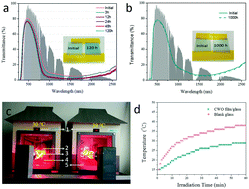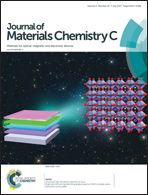CsxWO3 nanoparticle-based organic polymer transparent foils: low haze, high near infrared-shielding ability and excellent photochromic stability†
Abstract
Well-dispersed cesium-doped WO3 (CWO) nanocrystals are an attractive candidate as hosts that exhibit excellent near infrared-shielding ability owing to two kinds of absorptions: localized surface plasmon resonance absorption around 900 nm and small polaron absorption near 1800 nm. In this work, a simple thermal reduction method was introduced to synthesize a CWO powder, which was further dispersed by bead milling to obtain a CWO nanodispersion liquid. The CWO nanodispersion liquid can be employed to make a unique nonlinear optical foil with 70% visible transmittance and a near infrared transmittance less than 10%, while maintaining a high transparency with less than 1.0% haze. However, the main issue concerning CWO nanoparticle-based polymer foils is the detrimental photochromic effect under strong ultraviolet (UV) irradiation, which hampers their extensive application in energy-saving windows, such as in automobiles and architecture. Herein, the photochromic effect is largely relieved by embedding CWO nanoparticles into inert polyethylene terephthalate (PET) instead of mixing with resins like polyurethane or acrylic resin, and the final organic–inorganic nonlinear optical foils exhibit almost no coloration under strong UV illumination. Therefore, this study provides a new insight into making hybrid foils with high stability, transparency and multifunctionality in the optical and magnetic fields.



 Please wait while we load your content...
Please wait while we load your content...